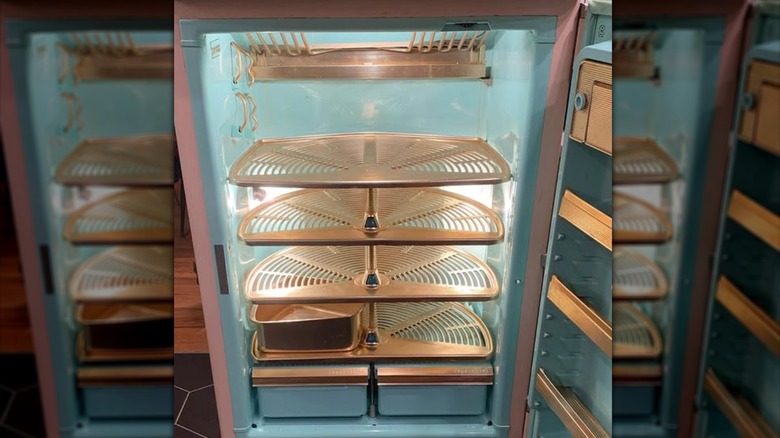The Convenient Vintage Fridge Feature That Needs To Make A Comeback
Wifi connectivity, smudge-free surfaces, and multi-door configurations are the trending refrigerator features of the modern age, but a fridge fad from the mid-20th century might have you yearning for something else. We know and love the venerable lazy Susan – wouldn't it be cool to apply its function inside the fridge? It was done, actually, back in the 1950s. At first, it might seem like a retro feature that went away for good reason, but the more you think about it, you realize how practical a rotating circular fridge shelf actually is. This, plus shelves that pulled out or flipped out, were convenient features of vintage fridges from that time.
If you haven't seen this design before, rotating fridge shelves are exactly what they sound like. They're circular trays (like a lazy Susan-style platform) built into the fridge interior. Instead of static shelves, these circular ones rotate manually. We've all lost bits and pieces of produce, Tupperware, and condiments in the back of the fridge, but with this design, the problem is solved. Not only is it a cool and creative design, but rotating shelves can reduce food waste.
This fridge feature also addresses the issue of dead space and organization. Often, we want to pull everything towards the front of a shelf to prevent losing items, but this isn't a problem with shelves that rotate. Taller items can be placed toward the center of the circular shelf, and smaller items along the edge, so all is visible at once. If every area is visible, this allows you to utilize every part of the shelf without empty spaces. One downside of circular shelves, however, is that the corners of the fridge are not usable space.
What happened to rotating shelves in the fridge?
Never seen a rotating shelf in a fridge before? You're likely wondering why. Despite how functional they were, modern refrigerators have phased out this mid-century feature. There is no clear-cut answer to what happened, but part of the reason is likely due to design trends. Older refrigerators were smaller, while new ones are bigger and more complex. With this size adjustment, design priorities shifted. These days, there is typically more surface area on static shelves and within refrigerator drawers, which most of us are using all wrong, anyway. Rotating shelves had less storage space, while the shelves themselves took up a lot of room.
Newer fridge models also boast a wider range of convenient features, like smart upgrades, ice makers, water dispensers, and screens. With all these upgrades, simple mechanical features, like rotating shelves, may be viewed as outdated. As more components were added and fridges became taller and more compartmentalized, the need for a row of circular shelves made less sense.
Now, there's a rise in adjustable shelving. These are certainly more useful than basic static ones, but movable flat shelves don't offer the same 360-degree access as the lazy Susan style. Although we've seen a lot of innovative fridge technology and designs, we hope that the rotating fridge shelf will eventually be one of the old-school kitchen trends making a comeback.

